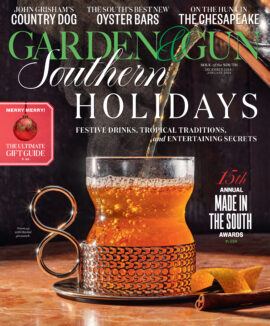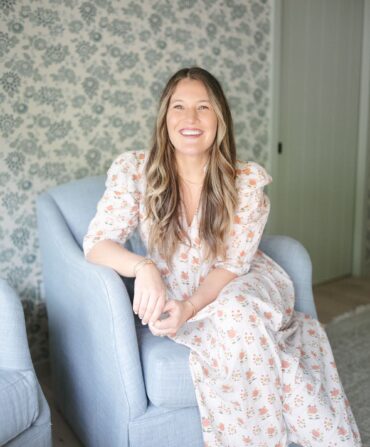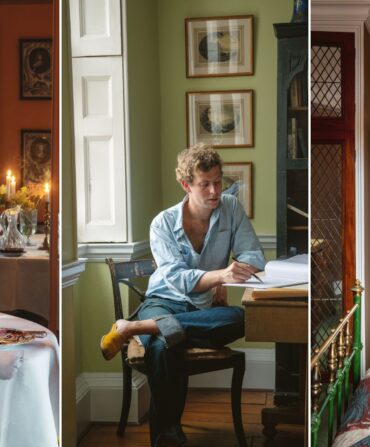Nebo Hill is Louise Bance’s favorite spot at Wheatland, the farm on the Rappahannock River that has been in her family for nearly two centuries. The twenty-eight-year-old Virginian currently lives and works in Manhattan but gathers with family at Wheatland every chance she gets. Though only an hour from Richmond and two hours from Washington, D.C., the farm, nestled among rolling hills, is still somehow magically secluded.
“Even if I arrive late for dinner or don’t get in until midnight, I always head up Nebo Hill,” Louise says. She’ll sit quietly, gazing up at the stars or down at the river. By day, you can see three counties from up there and boats plying the Rappahannock. Fittingly, the hill was named for Mount Nebo, where God sent Moses to view the promised land. Louise has made it a ritual to climb Nebo Hill and reflect. “I just take a big breath and think, ‘Everything’s okay. I’m here,’” she says.
The property has been in Louise’s family since about 1840, when an early ancestor, John Saunders, grew wealthy running a commercial steamboat wharf on a deep bend in the Rappahannock. The Bances spend holidays and long weekends in the two-story Greek Revival plantation house Saunders built overlooking the river. Sitting atop a raised brick basement, the five-bay frame house has two identical facades, each proudly greeting river or road with a two-story entry. A boxwood allée leads to the river’s edge, with a flower garden along the south side. The home has changed very little in 165 years. After the Civil War, the family had to sell furniture and silver to keep the property, but descendants later found original furniture, books, and oil portraits in the house’s attic. Over time, Louise’s family has added period-appropriate pieces bought from nearby antiques dealers.
“The house could be updated, but that’s not what we’re going for,” says Louise, who loves how the old-wood smell and creaking doors give the home personality. “It feels suspended in time.”
Louise, her sister Liza, and their three cousins are the next generation at Wheatland. The cousins and their fathers, Peter and Teddy Bance, respectively, co-own the estate, including the wharf, one of the lower Chesapeake Bay’s few remaining steamboat wharves.
Peter Bance is fiercely protective of his family’s rare river property, and he has every right to be. But he’s even more passionate about preserving the broader Rappahannock River valley, which he calls “an ecological nirvana.” The valley, he says, is one of the first stops for waterfowl on the eastern flyway and arguably the top bald-eagle habitat on the Eastern Seaboard. Downriver, once-vast oyster populations are finally making a comeback. The water teems with rockfish, catfish, perch, and herring. Giant oak, Osage orange, and pecan trees line the banks.

Photo: Patricia Lyons
A collection of game bird and waterfowl etchings.
It’s also culturally rich. “American history is written in this river,” says Peter, who launched the Essex County Countryside Alliance, a conservation group, in 2006. The Rappahannock was named for the Native Americans who inhabited its shores when Captain John Smith mapped the river in 1608. During the colonial era, the Rappahannock became an important transportation route. George Washington was born in nearby Westmoreland County. During the American Revolution, the British occupied the town of Tappahannock, sixteen miles downriver from Wheatland. Union troops occupied the region during the Civil War.
For Peter and the rest of the Bance family, much of the history is personal, too. Raised in Goochland County, near Richmond, Peter spent summers at Wheatland with his grandparents. They put him to work, but he found plenty of time to fish, shoot ducks, and dig for Native American artifacts and fossilized whale bones and giant shark teeth in the exposed bluffs. The family ate eggs from a henhouse and kept a smokehouse full of hams. “Everybody had a nice garden, like we still do,” he says. “It was and is a great way to live.”
Peter also grew up diving off the wharf’s pier pilings, a tradition passed down from generation to generation. The original Saunders wharf burned in 1900, but its 1901 replacement, a massive wooden warehouse perched on timbers along the bank, still stands. Today, kayaks and canoes fill stalls that once held livestock and bushels of wheat, and a Ping-Pong table stands amid old wagons and crab pots. A huge wooden grain bin serves as a beer cooler. During summer weekends, Louise says, “you’ll never find it empty.”

Photo: Patricia Lyons
Perfect Landing
Late afternoon on the river.
But life at Wheatland hasn’t always been idyllic. Over the years, the property has been threatened: first by the economic aftermath of the Civil War, then by the Great Depression, followed by harrowing periods of drought and hurricanes. After each trial, Wheatland has endured. Today’s biggest threat is riverfront development. “The river is the reason Wheatland and all the other beautiful old homes are here,” Peter says. “I’m not worried about the next five years. I’m worried about fifty years from now, after I’m gone.”
Which naturally raises the question: Will Louise and her generation be able to hang on to Wheatland?
“You never know what tomorrow’s going to bring,” Peter says, “but between them, I’m confident they’ll figure it out.”
For her part, Louise Bance says she’ll do whatever it takes. After all, she’s been up Nebo Hill and seen the promised land.









